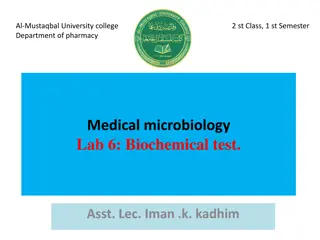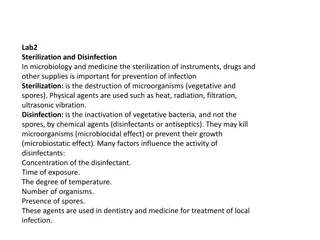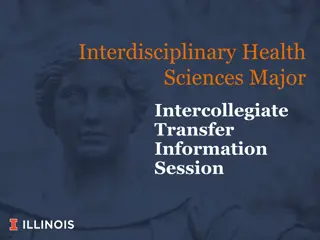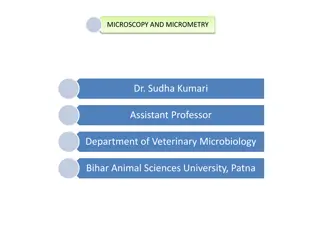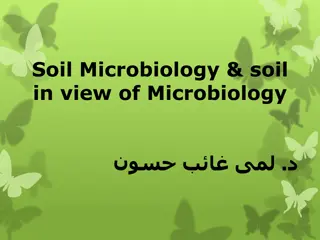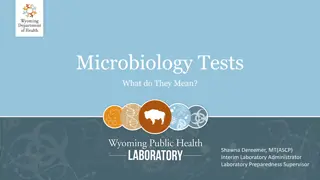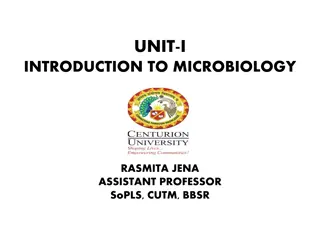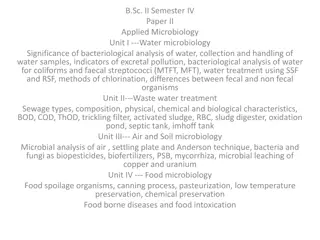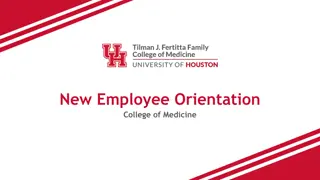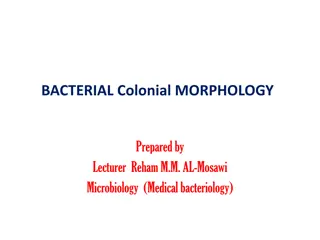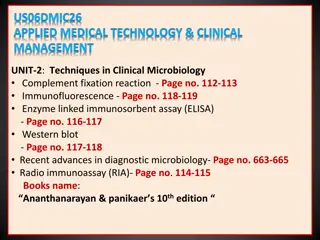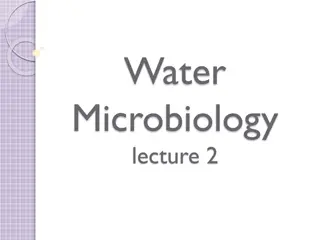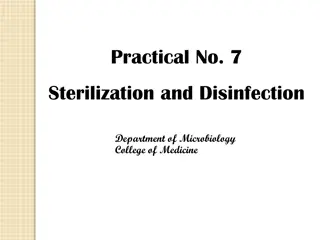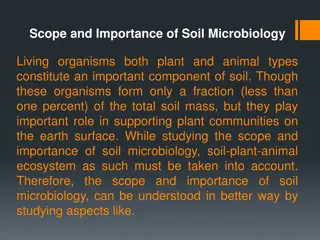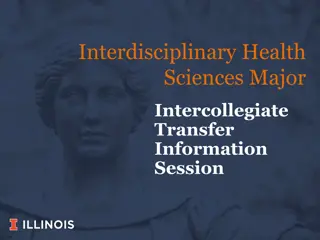The Significance of Microbiology in Health Sciences and Beyond
Microbiology plays a crucial role in understanding small living organisms, including pathogens and non-pathogens. Studying microbiology is essential due to the prevalence of microorganisms in our body, their role in the food chain, and their applications in various industries like food, beverage, antibiotic production, and genetic engineering. The history of microbiology showcases pioneers like Antoni van Leeuwenhoek and Louis Pasteur, who made significant contributions to the field.
Download Presentation

Please find below an Image/Link to download the presentation.
The content on the website is provided AS IS for your information and personal use only. It may not be sold, licensed, or shared on other websites without obtaining consent from the author. Download presentation by click this link. If you encounter any issues during the download, it is possible that the publisher has removed the file from their server.
E N D
Presentation Transcript
Reference : Burton's Microbiology for the Health Sciences By Paul G Engelkirk, Janet Duben-Engelkirk Lippincott Williams & Wilkins (2010), Ninth Edition.
Microbiology Biology . Micro Microbiology organisms is the study of very small living Microorganisms are EITHER Pathogens OR Non-pathogens.
Why Should We Study Microbiology? Microorganisms living on and inside us are 10 times more than the no. of our cells. These microorganisms are called Normal Flora ( indigenous microflora) opportunistic pathogens ?? Microorganisms are part of the food chain as tiny animals feed on them. Others are involved in elemental cycles like carbon, nitrogen, sulfur
Why Should We Study Microbiology? Many microorganisms are essential in various food and beverage industries Some bacteria and fungi used to produce antibiotics Microorganisms are essential in the field of genetic engineering
Pioneers in the Science of Microbiology 1.Antoni van Leeuwenhoek. 2.Louis Pasteur. 3.Robert Koch.
Antoni van Leeuwenhoek (Holland 1632-1723) The father of microbiology: he is the first one to see living bacteria and protozoa. He was the first to create what is known today as single lens microscope by grinding tiny glass lenses and putting them in metal frames.
Louis Pasteur (France 1822-1895) 1. He discovered the process of alcohol fermentation. 1. Developed a process called Pasteurization . 1. He discovered forms of life that can exist in the presence of oxygen called aerobes and ones that can exist in the absence of oxygen anaerobes
Louis Pasteur (France 1822- 1895) 4. He discovered the infectious agent that affect silk industry. 5. He made significant contribution to the germ theory of disease 5. He developed vaccine for dog and human rabies.
Robert Koch (Germany 1843-1910) 1. He made significant contribution to the germ theory of disease. 2. He developed methods of fixing, staining, and photographing bacteria. 3. He developed methods for culturing bacteria on solid media. 4. He discovered the bacterium (Mycobacterium tuberculosis) that cause tuberculosis and Invented skin test to diagnose the Tb. 5. He discovered the bacterium (Vibrio cholerae) that causes cholera.
Classification of Microorganism Cellular Acellular Prokaryotes Eukaryote s ex. Viruses. ex. Algae, protozoa, fungi, plants, animals, and humans. ex. Bacteria
Comparison between Eukaryotic and prokaryotic Eukaryotic Cell Plant animal Prokaryotic Cell Biological distribution Nuclear Membrane Membranous structures other than cell membrane Cytoplasmic ribosome's (density) Cell wall chromosomes
Taxonomy Taxonomy is the science of classifying living organisms. Classification : The arrangement of organisms into taxonomic groups (taxa) on the basis of similarities or relationships. The taxa include: Kingdom (5 major divisions) Phylum (groups of related Classes) Class (groups of related Orders) Order (groups of related Families) Family (groups of related Genera) Genus (groups of related Species) Species (living organisms that are alike)
The Five Kingdoms 1. Monera (unicellular prokaryotes: bacteria, cyanobacteria, blue-green algae 2. Protista (unicellular eukaryotes: protozoa, unicellular algae, slime molds) 3. Fungi (multicellular eukaryotes: molds, mushrooms, yeasts) 4. Plantae (multicellular eukaryotes: plants) 5. Animalia (multicellular eukaryotes: animals)
Relationships between Organisms Symbiosis Permanent association between two different organisms. There are several kinds of symbiosis Neutralism Two organisms living together, andneither is affected by that. Commensalism: Two organisms living together, one is benefited and the other is not been affected. Mutualism Two organisms living together, and both benefit from that. Parasitism: Two organisms living together, one is benefited called parasite and the other is harmed called host . Synergism: Sometimes, two (or more) microorganism may work together team up to produce a disease that neither could cause by itself.











